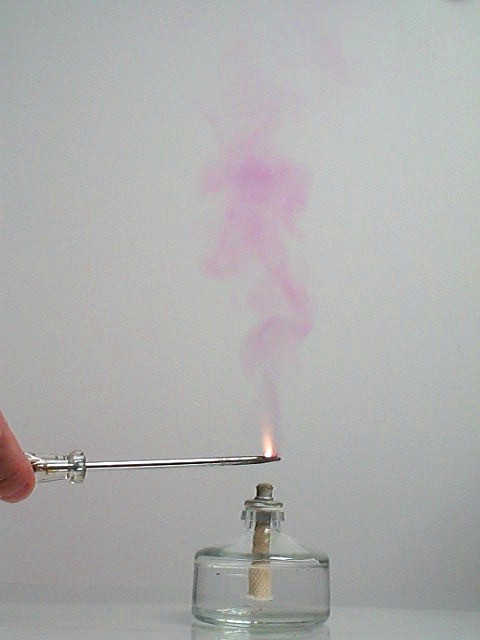


Pyrotechnic mix with purple gas
Usually, when a pyrotechnic mix is burnt, light is emitted and a lot of smoke is produced. In this experiment, a mix is shown, which does not produce any smoke, but instead a purple purely gaseous mix is produced.
The mix is simple and easy to make. For this experiment, 100 mg of potassium metaperiodate (KIO4) was mixed with 40 mg of sulphur. Both chemicals were finely powdered and thoroughly mixed. The resulting powdered mix can easily be ignited. It burns fairly slowly, with a small flame, producing a purple gaseous mix. This gaseous mix is very pungent and it has a strong smell of sulphur dioxide.

The picture, shown above, is from a video: burning of KIO4+S. Download size is just below 1 MByte.
In this experiment, the sulphur partly is oxidized to sulphur dioxide. This gives the strong and pungent smell. A solid white molten salt mix remains behind. This molten salt mix easily dissolves in water. It contains a small amount of sulfate ion (which can be detected with a solution of barium chloride in distilled water). It also contains iodide ion.
The main reaction seems to be:
KIO4 + 2S → KI + 2SO2
But there is a side reaction, which gives rise to formation of iodine and potassium sulfate. Most likely, this can best be described as:
2KIO4 + 3S → K2SO4 + I2 + 2SO2
This side reaction is not dominant. The purple color is due to iodine vapor, but it is not really strong. Given the intense color of iodine vapor, one can conclude that the vapor is not really dense in iodine. The test with barium sulfate also shows that only a small amount of sulfate ion is present in the molten salt mix after burning.
Finally, there might be a side reaction, in which potassium sulfite is formed, instead of potassium sulfate. This may be particularly true in this experiment, because with 40 mg of sulphur and 100 mg of potassium metaperiodate, the mix is deficient in metaperiodate.